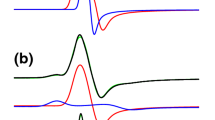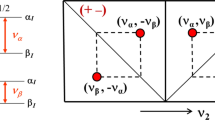Abstract.
Hydrons and electrons are substrates for the enzyme hydrogenase, but cannot be observed in X-ray crystal structures. High-resolution 1H electron nuclear double resonance (ENDOR) spectroscopy offers a means to detect the distribution of protons and unpaired electrons. ENDOR spectra were recorded from frozen solutions of the nickel-iron hydrogenases of Desulfovibrio gigas and Desulfomicrobium baculatum, in the "active" state ("Ni-C" EPR signal) and analyzed by orientationally selective simulation methods. The experimental spectra were fitted using a structural model of the nickel-iron centre based on crystallographic results, allowing for differences in electron spin distribution as well as the spatial orientation of the g-matrix (g-tensor), and anisotropic and isotropic hyperfine couplings of the protons nearest to the nickel ion. ENDOR signals, detected after complete deuterium exchange, were assigned to six protons of the cysteines bound to nickel. The assignment took advantage of the substitution of a selenium for a sulfur ligand, which occurs naturally between the [NiFeSe] and [NiFe] hydrogenases from Dm. baculatum and D. gigas, respectively, and was found to affect just two signals. The four signals with the largest hyperfine couplings, including isotropic contributions from 4.5 to 13.5 MHz, were assigned to the β-methylene protons of the two terminal cysteine ligands, one of which is substituted by seleno-cysteine in [NiFeSe] hydrogenase. The electron spin is delocalized onto the nickel (50%) and its sulfur ligands, with a higher proportion on the terminal than the bridging ligands. The g-matrix was found to align with the active site in such a way that the g 1-g 2 plane is nearly coplanar (18.3°) with the plane defined by nickel and three sulfur atoms, and the g 2 axis deviates by 22.9° from the vector between nickel and iron. Significantly for the reaction of the enzyme, direct evidence for the binding of hydrons at the active site was obtained by the detection of H/D-exchangeable ENDOR signals.
Similar content being viewed by others
Author information
Authors and Affiliations
Additional information
Electronic Publication
Rights and permissions
About this article
Cite this article
Müller, A., Tscherny, I., Kappl, R. et al. Hydrogenases in the "active" state: determination of g-matrix axes and electron spin distribution at the active site by 1H ENDOR spectroscopy. J Biol Inorg Chem 7, 177–194 (2002). https://doi.org/10.1007/s007750100285
Received:
Accepted:
Published:
Issue Date:
DOI: https://doi.org/10.1007/s007750100285




